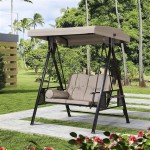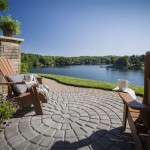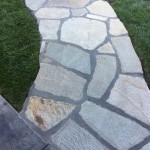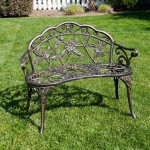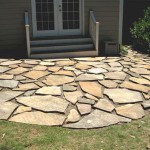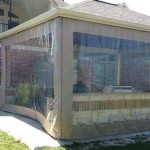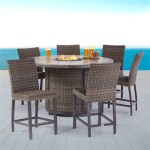How To Repair a Concrete Patio Table Top
A concrete patio table can be a durable and attractive addition to outdoor spaces. However, exposure to the elements, general wear and tear, or accidental impacts can lead to cracks, chips, and other forms of damage to the concrete surface. Repairing a concrete patio table top not only restores its aesthetic appeal but also extends its lifespan and prevents further deterioration. This article offers a comprehensive guide on how to effectively repair a concrete patio table top, covering essential materials, necessary preparations, and step-by-step repair procedures.
Before commencing any repairs, a thorough assessment of the damage is crucial. This involves identifying the types and extent of defects present on the table top. Minor cracks, spalling, or chips require different approaches compared to more significant structural damage. Cleaning the surface thoroughly is also paramount to ensure proper adhesion of repair materials. Addressing any underlying issues, such as unstable support or persistent moisture exposure, will enhance the longevity of the repair.
Key Considerations Before Starting Repairs
Successfully repairing a concrete patio table top involves careful planning and preparation. Several key factors must be considered prior to initiating the repair process. These include assessing the type and extent of damage, gathering the appropriate materials and tools, and preparing the work area to ensure a clean and safe environment.
The first step is to meticulously examine the table top for any cracks, chips, or other forms of damage. Minor surface imperfections can often be addressed with patching compounds, while larger cracks or structural damage may require more extensive repairs involving epoxy or concrete resurfacing products. Accurately assessing the extent of the damage will help determine the appropriate repair strategy and the necessary materials.
The selection of appropriate repair materials is crucial for achieving durable and aesthetically pleasing results. For small cracks and chips, a concrete patching compound specifically designed for exterior use is generally suitable. For larger cracks or spalled areas, a two-part epoxy concrete repair system may be necessary to provide adequate strength and bond. Concrete resurfacing products can be used to restore a heavily damaged or uneven surface. When choosing materials, it is important to consider factors such as weather resistance, durability, and compatibility with the existing concrete.
Proper preparation of the work area is essential for successful concrete repair. This involves cleaning the table top thoroughly to remove any dirt, debris, or loose particles that could hinder the adhesion of the repair materials. A wire brush, scraper, or pressure washer can be used to remove stubborn contaminants. Protecting the surrounding area with drop cloths or plastic sheeting will prevent accidental spills or splatters of repair materials. Ensuring adequate ventilation is also important, especially when working with epoxy or other solvent-based products.
Step-by-Step Repair Procedures
Following a structured approach when repairing a concrete patio table top ensures consistent and effective results. The repair process typically involves cleaning and preparing the damaged area, applying the appropriate repair material, and finishing the surface to blend seamlessly with the existing concrete. Detailed instructions are provided for each step, covering the necessary tools, techniques, and precautions.
Before applying any repair materials, the damaged area must be thoroughly cleaned to remove any loose particles, dirt, or debris. Use a wire brush to scrub away any loose concrete or flaking material. A chisel and hammer can be used to remove any severely damaged or crumbling sections. For oily or greasy stains, a degreasing cleaner should be applied, followed by thorough rinsing. The cleaned surface should be dry before proceeding to the next step.
Once the area is cleaned and prepared, the appropriate repair material can be applied. For minor cracks and chips, use a concrete patching compound designed for exterior use. Follow the manufacturer's instructions for mixing and application. Apply the patch to the damaged area with a putty knife or trowel, pressing it firmly into the crack or chip. Overfill the area slightly to allow for shrinkage during the curing process. Smooth the surface with the trowel, blending it with the surrounding concrete. Allow the patch to cure according to the manufacturer's instructions.
For larger cracks or spalled areas, a two-part epoxy concrete repair system may be necessary. Follow the manufacturer's instructions for mixing the epoxy components. Apply the mixed epoxy to the damaged area with a trowel, ensuring that it penetrates deeply into the cracks and voids. Level the epoxy with the surrounding concrete, using a straight edge or trowel. For very deep cracks, multiple applications of epoxy may be necessary. Allow the epoxy to cure completely before moving on to the next step.
After the repair material has fully cured, the surface should be finished to blend seamlessly with the surrounding concrete. Use a concrete grinding stone or sandpaper to smooth any unevenness or rough patches. Start with a coarse grit and gradually move to a finer grit to achieve a smooth finish. Feather the edges of the repair area to blend it with the existing concrete. If necessary, apply a concrete stain or sealant to match the color and texture of the surrounding concrete. Allow the stain or sealant to dry completely before using the table top.
Sealing and Maintaining the Repaired Surface
Protecting the repaired concrete patio table top from future damage is equally important as the initial repair. Applying a sealant and following a regular maintenance routine can significantly extend the lifespan of the repair and maintain the table's aesthetic appeal.
Sealing the repaired concrete surface provides a protective barrier against water penetration, stains, and weathering. A concrete sealer designed for exterior use is recommended. Apply the sealant according to the manufacturer's instructions, ensuring even coverage. Multiple coats may be necessary for optimal protection. The sealant should be allowed to dry completely before using the table top.
Regular cleaning and maintenance are essential for preserving the appearance and integrity of the repaired concrete patio table top. Sweep or vacuum the surface regularly to remove any dirt, debris, or leaves. For stains or spills, clean the surface immediately with a mild detergent and water. Avoid using harsh chemicals or abrasive cleaners, as they can damage the sealant or the concrete surface. Inspect the table top periodically for any new cracks or signs of damage, and address them promptly to prevent further deterioration.
Properly supporting the concrete patio table top also contributes to its longevity. Ensure that the table base is stable and evenly distributes the weight of the table top. If the base is wobbly or uneven, adjust the legs or add shims to provide a stable foundation. Avoid placing excessive weight on the table top, as this can cause stress and cracking. During periods of extreme weather, such as freezing temperatures or heavy rain, consider covering the table with a waterproof tarp to protect it from the elements.
Implementing these repair procedures, along with consistent maintenance, will ensure the longevity and visual appeal of the concrete patio table top. By taking a proactive approach to identifying and addressing potential issues, homeowners can enjoy their outdoor furniture for many years to come.

Cement Coating An Outdoor Table

Cement Coating An Outdoor Table

How Should I Refinish Our Concrete Table Top Hometalk

Cement Coating An Outdoor Table

Cement Coating An Outdoor Table

Diy Concrete Table Top She Holds Dearly

How To Make A Concrete Table Polished Top With Recycled Glass

Build Your Own Concrete Table Diy

How To Repair And Resurface Old Concrete Patios Fixing Ugly

Fail Patio Table Top Replacement 5 Steps With Pictures Instructables
Related Posts

